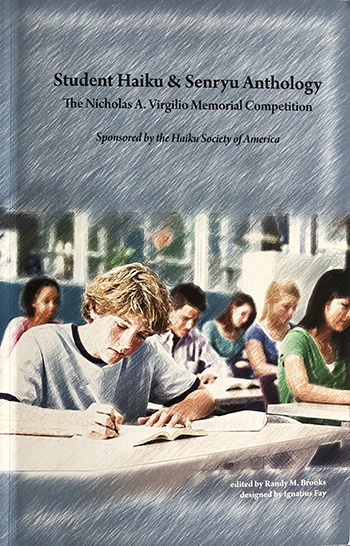Haiku Society of America Student Haiku Awards
in Memorial of Nicholas A. Virgilio
~ ~ ~
Student Haiku Awards for 2011
Francine Banwarth and Tom Painting
judges
.November sky
a lone seed drifts
on wispy wingsMartine Thomas
Wilson Commencement School, Age 14, Grade 9, Rochester, NYNovember is the eleventh month of the year; the word itself suggests a feeling of longing as our eyes are directed toward the wide expanse of sky. Each line is balanced with four well-chosen syllables and a controlled rhythm that moves the reader through the poem. One can only wonder at the origin of the seed. Is it from a meadow, a vacant city lot? The November sky foreshadows winter, the imagery of which often centers on grief, distance, loss, and at times serenity. There is a vulnerability suggested in this haiku, but also a hint of hope. Will this seed come to rest on fertile ground? Will it fulfill its promise? The poet has fulfilled hers/his in this well-crafted haiku which gives us something to ponder.
August night
eau de rain
drifts on the windMartine Thomas
Wilson Commencement School, Age 14, Grade 9, Rochester, NYThis haiku engages our senses—sight, sound, smell, touch, perhaps even taste. "Eau de rain" is in and of itself a lovely expression. In translation from the French, "eau de" may be interpreted as "scent of." The use of the French language adds a hint of mystery: nature's perfume, or the scent of some human presence? Together with the opening line and the well-chosen verb "drifts" in line three, the poem flirts with the notion of change, a shift in the weather and for that matter the season that can be perceived through the senses.
AP Physics
my eyes
twitchHeather Zadra
Sage Hill School, Age 18, Grade 12, Newport Coast, CAOne measure of a successful senryu is to elicit from the reader a near instantaneous response. With a delightful and effective use of juxtaposition, there is no need to guess what this young author experiences as the brain tries to navigate advanced study in physics. If physics is the study of matter and its motion through space-time, then the poet has taken a moment along the continuum and made a precise and valid observation, the meaning of which registered with us at the speed of light.
story time
under the covers
the night’s warm whispersMariah Wilson
Sage Hill School, Age 14, Grade 9, Newport Coast, CAThe alliterative quality of the words chosen by the poet is admired in this senryu. Upon reflection, Tom found himself remembering the bedtime stories told to him as a child and in more recent times having the pleasure of telling some of those same stories to his own children. The ritual of story time is timeless. The middle line of this poem serves as a pivot. It works simultaneously with the first and third lines and evokes a feeling of seamlessness. The poet is aware of the special relationship between the storyteller and listener, a quiet moment of warm intimacy as the noise of the day fades away to sleep and dreams.
~ ~ ~
About our 2011 judges:
Francine Banwarth began writing and studying haiku in 1988. She is a co-founder of Haiku Dubuque and leads haiku workshops at The Foundry Books in Mineral Point, Wisconsin. She served as second vice president of the Haiku Society of America for three years and currently serves on the board of Modern Haiku. Her work appears in a variety of journals, anthologies, and contests. She is refining a workshop, "A Writing Life in Seventeen Syllables or Less," presented at the May 2011 Haiku Society of America midwest regional meeting in Evanston, IL.
Tom Painting taught middle and high school creative writing for seventeen years at School of the Arts in Rochester, NY. He has been active in the haiku community for more than a decade. He served as first and second vice-president of the Haiku Society of America and was coeditor the editor of the 2005 Haiku Society of America member's anthology. Most recently Tom taught a haiku course for adults at The Institute for Lifelong Learning at Emory University in Atlanta where he now resides.
